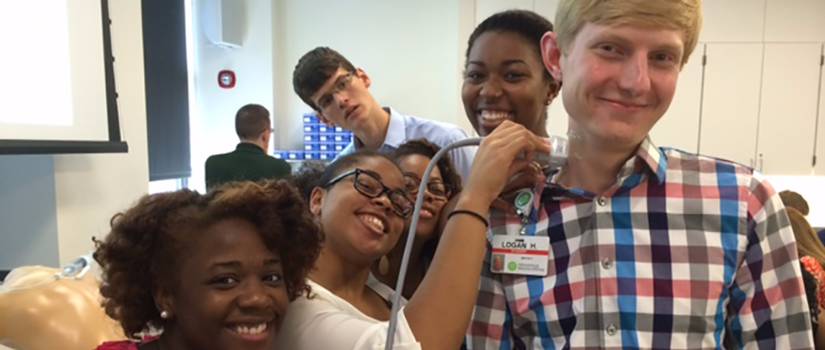In Logan's Words
We Make Surgery Possible
Over the past two days, I have had the pleasure of learning about the field of anesthesiology from an anesthesiologist and a certified registered nurse anesthetist (CRNA) that work in the operating rooms of the Greenville Health System. Doctors and nurses work together as a part of the surgical team to accomplish many tasks in surgery, and I was able to practice some of these procedures on mannequins in the simulation center of the USC School of Medicine Greenville. The first was a subarachnoid block, which completely blocks the innervation below the site of injection into the cerebrospinal fluid. This is used for procedures usually done on the lower body where sensory and motor controls need to be blocked. Once you open the kit, the skin and outer layers of tissue must be numbed with a small needle, and then the inserter needle is placed between the spinal processes of L4. The longer, thinner needle is then pushed through the inserter needle until it just penetrates the cerebrospinal membrane. A thinner needle is used to reduce the size of the hole in the cerebrospinal membrane, preventing too much cerebrospinal fluid from leaking out. The needle is then checked for fluid leakage to confirm that it is in the subarachnoid space. After this is confirmed, the medication can be pushed in, and then all of the needles are pulled out at once. The loss of nervous control is very fast, so the patient must quickly be moved into the position the surgeon needs.
We also learned how to perform an intubation, also using an anatomically correct mannequin. When a patient is put under general anesthesia, three types of drugs are given. One is to remove pain, another is to induce amnesia and stop the formation of new memories, and the third is a paralytic agent to stop all skeletal muscle movement. When the paralytic agent takes full effect, the diaphragm is paralyzed and normal breathing stops. At this point the person in charge of the airway (usually the CRNA at GHS) must work quickly to attach the patient to a ventilator. This is done using a curved device with a light on the end, which is maneuvered through the mouth and pulls back the tongue to expose the vocal cords. The endotracheal tube is then inserted into the lungs through the vocal cords, and a small balloon below the cords is inflated to keep the tube in place. The tube is manually ventilated until it can be attached to a ventilator machine that can continue the patient’s breathing. After surgery when normal breathing resumes, the balloon is deflated and the tube is pulled out. This occurs before the patient wakes up, and he or she usually never knows that a CRNA was there maintaining the breathing throughout the procedure. Without these techniques of anesthesia, surgery would involve severe amounts of pain and psychological trauma. Professionals in the field of anesthesiology offer a unique form of medicine without which surgery would not be possible.
Shifting the Focus from Hospitals to Health
This summer I had the privilege of being accepted to the MedEx Academy at the Greenville Health System. MedEx is a summer program that has 4 tiers for various age groups. I was selected to be a part of Tier III, which focuses on preparation for medical school and an in-depth analysis of the way American healthcare is evolving to meet the needs of modern society. America’s healthcare system is the most expensive in the world; we spend about 18% of our GDP on healthcare, which totals around $3,000,000,000,000 per year. One would assume that if we spend the most on healthcare, we would have the highest level of health. Sadly this is far from the truth, since the United States’ average life expectancy ranks 42nd in the world. To compare that with another industrialized nation, Japan has the 3rd highest life expectancy, is the 3rd largest economy in the world, and only spends 10% of its GDP on healthcare.
In the program, we spend a lot of time discussing ways to make our healthcare system more effective and efficient. We are learning that it is vitally important to treat all aspects of a person’s life, not just their health as it appears in lab tests. To develop experience in this approach to medicine, our clinical project is bibliotherapy, which involves reading to patients in nursing homes as a way of creating meaningful conversation and mental stimulation. I am assigned to a facility that treats many Alzheimer’s and dementia patients, so interactions are sometimes difficult. It is clear, however, that some interactions are a very successful way of stimulating the mind and helping to lower the patients’ stress levels. I look forward to participating in bibliotherapy sessions and utilizing these skills as I continue my journey of becoming a healthcare provider.
